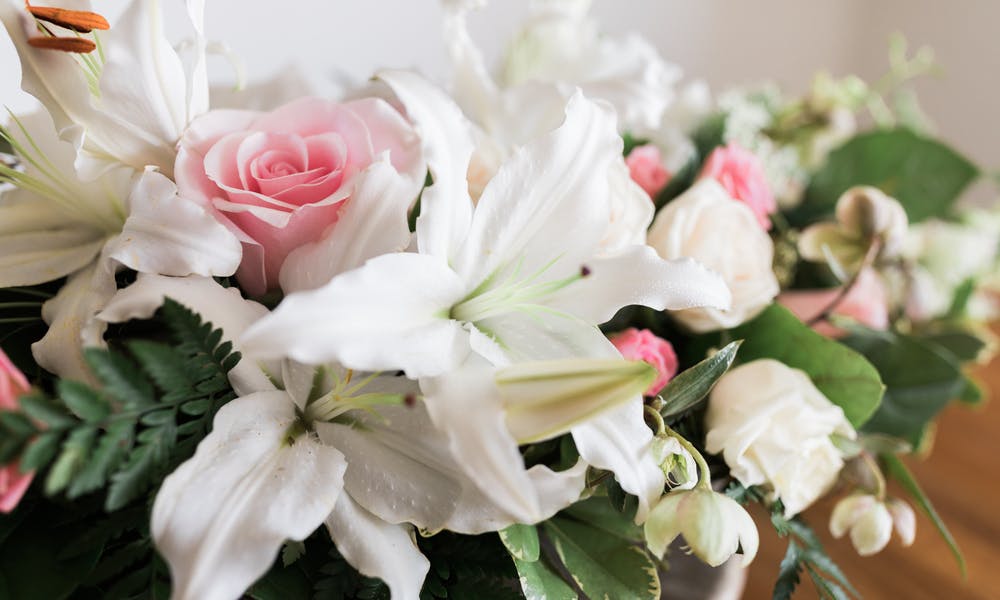When it’s hard to find the words, flowers are a heartfelt way to show your sympathy to a grieving family when they have lost a loved one. Flowers offer comfort and let the family know they are in your thoughts.
When you read this article, you can learn:
* Considerations Before Choosing Flowers
* Choosing the Type of Flowers
* How to Send Flowers to a Funeral
* After the Funeral
Considerations Before Choosing Flowers
When choosing a floral arrangement, take into consideration the faith of the deceased as well as their family’s. Knowing their faith, traditions and cultural beliefs help guide your choice of flowers.
In the Christian religion, there are no restrictions of color or types of flowers. So, your preference is your choice.
In the Morman faith, it is suggested that you refrain from arrangements with crucifixes or crosses. Otherwise, there is no restriction on your choice of flowers.
In the Greek Orthodox Church, white is the most common flower color chosen.
Generally, in the Jewish faith, it is more appropriate to send the flowers to the family member’s home because flowers are not used at the funeral home where the service is held. A word of caution, do not take or send flowers to the home of a Jewish family who is sitting Shiva, which is the seven days of mourning following the burial of the deceased.
Because beliefs vary across the Muslim faith, it’s better to ask the family of the deceased what their desire is before sending flowers.
Type of Arrangements
When deciding on the type of arrangement, consider your relationship to the deceased. An immediate family member may choose a wreath or casket spray. Other choices may include table arrangements for the gathering after the service or swags for the inside of the casket lid.
Extended family members may select a standing spray or a less formal arrangement. Close friends and coworkers have several choices including a wreath, a spray, a basket arrangement, a bouquet or a live plant. In the case of friends, it is both appropriate to send the flowers to either the funeral home or the family’s home.
Once you have determined the appropriate style of arrangement and where to send it, you can add personal touches and meaning. One way to honor the deceased is to choose or create a unique bouquet that recognizes their interests and passions. For example, if the deceased loved to travel, send a bouquet of their favorite country’s flowers. Or, if they loved gardening, give a plant that the family can plant outdoors honoring their lost family member. The plant reminds the family of their loved one as it continues to grow.
Choosing the Type of Flowers
With a little thought, you can send the flower that expresses your thoughts and feelings for the family. Here are some of the most popular flowers to add to an arrangement and what they symbolize:
* Apple Blossom symbolizes better things to come
* Lilies of the Valley show a desire for the return of happiness
* An ivy plant expresses eternal fidelity
* Hybrid tea roses express a heartfelt eternal remembrance
* Chrysanthemums are traditionally used in funerals by Asian families.
Once you have determined the type of flower, don’t forget to put a little extra thought into the color as well:
* White flowers represent peace
* Red roses as always show love, respect, and courage
* Blue flowers show comfort and caring
Avoid the color green for it represents health and good fortune. Also, avoid red when attending a Buddhist funeral.
How to Send Flowers to a Funeral
After putting all the effort into choosing a style of arrangement, and the color, there is one last step, sending the flowers. Be sure to check with the funeral home to see if there are any restrictions such as glass vases that may tip over and break. Tell the florist of any restrictions when ordering.
When ordering you need to provide the name, date, time, and location of the service. Because this is a difficult time to find the right words to comfort those that have lost their loved ones, remember a simple message such as “with deepest sympathy” is always appropriate.
If ordering online, most florists have a link for ordering funeral or sympathy arrangements. The arrangements can be sent to the funeral home, house or even out of state.
After the Funeral
After the funeral, there are many ways to use the flowers. The family of the bereaved may take one or two of the arrangements home to enjoy. If the flower is a plant it can be taken home and planted in a garden as a living memorial.
The petals of the flowers can be dried and preserved and used in many craft projects such as potpourri, jewelry, candles, or laminated onto a bookmark.
Some of the arrangements can be given to close family and friends to take home.
In a lot of cemeteries, the headstone is not available by the time of service. The flowers from the service can be put on the gravesite for adornment. Be sure to remove any items that may come loose in the wind and litter the grounds.
And finally, consider taking flowers to a retirement home, hospital, or hospice. Call ahead to check for restrictions that they may have, specifically regarding allergies of the residents. Remove any funeral indicators such as cards, crosses, or ribbons. Do not give a casket spray unless it has been dismantled and rearranged as smaller bouquets or arrangements.
Conclusion
Funerals are a time for loved ones to find support and comfort from family and friends. It is a time to celebrate the joy and accomplishments of the deceased. Choosing the right flowers and arrangement can say so much at a time when choosing the right words is a challenge. Flowers honor the deceased and bring comfort to those in mourning.
